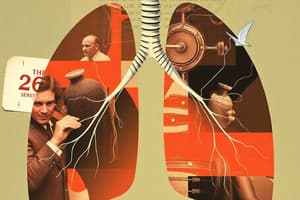Podcast
Questions and Answers
What characterizes restrictive lung diseases?
What characterizes restrictive lung diseases?
- Decreased lung compliance and decreased lung volumes (correct)
- Normal compliance but increased airway resistance
- Increased lung volumes with normal flow rates
- Normal lung volumes with high expiratory pressure
How does obstructive lung disease primarily affect pleural pressure during exhalation?
How does obstructive lung disease primarily affect pleural pressure during exhalation?
- It causes an increase in positive pleural pressure (correct)
- It decreases pleural pressure due to increased airflow
- It has no effect on pleural pressure
- It results in negative pleural pressure maintenance
What is the primary dysfunction caused by an ineffective thoracic pump?
What is the primary dysfunction caused by an ineffective thoracic pump?
- Decreased resistance in the airways
- Ventilatory dysfunction and decreased lung volume (correct)
- Increased lung capacity and improved ventilation
- Enhanced respiratory rates and flow rates
Which of the following correctly states the conditions of flow rates in restrictive lung diseases?
Which of the following correctly states the conditions of flow rates in restrictive lung diseases?
What is primarily affected by the entry of air from the atmosphere down to the alveoli in restrictive defects?
What is primarily affected by the entry of air from the atmosphere down to the alveoli in restrictive defects?
What condition is characterized by an elevation in arterial PCO2 due to inadequate alveolar ventilation?
What condition is characterized by an elevation in arterial PCO2 due to inadequate alveolar ventilation?
What does the Flow Volume Loop primarily measure?
What does the Flow Volume Loop primarily measure?
Which of these conditions results in a decrease in arterial PCO2?
Which of these conditions results in a decrease in arterial PCO2?
What does FEF25-75 represent?
What does FEF25-75 represent?
What is the effect on pH during respiratory acidosis caused by hypercapnia?
What is the effect on pH during respiratory acidosis caused by hypercapnia?
Which parameter is NOT typically displayed in a flow-volume loop?
Which parameter is NOT typically displayed in a flow-volume loop?
What does an increase in arterial PCO2 typically indicate?
What does an increase in arterial PCO2 typically indicate?
Which of the following best describes the function of the expiratory flow-volume curve?
Which of the following best describes the function of the expiratory flow-volume curve?
What does Forced Expired Volume in one second (FEV1) primarily measure?
What does Forced Expired Volume in one second (FEV1) primarily measure?
During a normal resting respiration, how does the water content of exhaled gas compare to that of inhaled gas?
During a normal resting respiration, how does the water content of exhaled gas compare to that of inhaled gas?
Which condition does not relate to obstructive defects in ventilatory dysfunction?
Which condition does not relate to obstructive defects in ventilatory dysfunction?
What is a key characteristic of Forced Expired Volume in one second (FEV1)?
What is a key characteristic of Forced Expired Volume in one second (FEV1)?
What is the equation that defines minute ventilation?
What is the equation that defines minute ventilation?
In the context of respiratory health, what typically happens to the volume of exhaled gas during respiration?
In the context of respiratory health, what typically happens to the volume of exhaled gas during respiration?
Which gas laws are essential for understanding ambient air and alveolar ventilation?
Which gas laws are essential for understanding ambient air and alveolar ventilation?
Which of the following statements about ventilatory dysfunction is accurate?
Which of the following statements about ventilatory dysfunction is accurate?
Ambient air is primarily composed of which gases?
Ambient air is primarily composed of which gases?
What implication does a thoracic pump being ineffective have on alveoli?
What implication does a thoracic pump being ineffective have on alveoli?
What concept emphasizes carbon elimination rather than alveolar oxygenation in ventilation?
What concept emphasizes carbon elimination rather than alveolar oxygenation in ventilation?
What is NOT a characteristic of air passage during obstructive defects?
What is NOT a characteristic of air passage during obstructive defects?
Which statement accurately describes Boyle’s law?
Which statement accurately describes Boyle’s law?
What is the typical minute ventilation for a 60-kilogram man?
What is the typical minute ventilation for a 60-kilogram man?
How is alveolar ventilation initiated?
How is alveolar ventilation initiated?
Which component measures the volume of air that reaches the alveoli for gas exchange?
Which component measures the volume of air that reaches the alveoli for gas exchange?
What effect does an increase in gas density have on airway resistance?
What effect does an increase in gas density have on airway resistance?
Which of the following correctly defines tidal volume?
Which of the following correctly defines tidal volume?
How does an oxygen-helium mixture affect airway resistance?
How does an oxygen-helium mixture affect airway resistance?
What role does airway mucus and edema play in ventilation?
What role does airway mucus and edema play in ventilation?
In relation to individuals with asthma, what is the significance of airway resistance fluctuations?
In relation to individuals with asthma, what is the significance of airway resistance fluctuations?
Which of the following statements is true regarding expiratory reserve volume?
Which of the following statements is true regarding expiratory reserve volume?
What is the primary consequence of bronchial smooth muscle contraction on ventilation?
What is the primary consequence of bronchial smooth muscle contraction on ventilation?
Which of the following statements regarding low-density gas inhalation is accurate?
Which of the following statements regarding low-density gas inhalation is accurate?
Flashcards are hidden until you start studying
Study Notes
Breathing Frequency and Lung Volumes
- Tidal volume (TV) and respiratory rate (RR) together determine minute ventilation (MV).
- MV is calculated using the formula: MV = TV x RR.
- Normal minute ventilation is approximately 6.8 liters per minute in a 60 kg individual.
- Effective ventilation primarily focuses on carbon dioxide (CO2) elimination rather than alveolar oxygenation.
Alveolar Ventilation and Gas Laws
- Alveolar ventilation starts with ambient air, a gas mixture primarily consisting of nitrogen (N2) and oxygen (O2), with traces of CO2 and other gases.
- Key gas laws governing ambient and alveolar ventilation include:
- Boyle’s Law: Pressure and volume are inversely related at constant temperature.
- Dalton’s Law: Total pressure is the sum of individual gas pressures.
- Henry’s Law: The amount of gas dissolved in a liquid is proportional to its partial pressure.
Respiratory Conditions
- Hypercapnia (elevated arterial PCO2 due to hypoventilation) leads to respiratory acidosis.
- Hyperventilation occurs when alveolar ventilation exceeds CO2 production, resulting in hypocapnia (decreased arterial PCO2).
Flow-Volume Loop
- A flow-volume loop graphically represents airflow during forced expiration and inspiration.
- It shows:
- Peak expiratory flow rate (PEFR): highest flow during exhalation.
- Changes in flow at various lung volumes.
Ventilatory Dysfunction
- Restrictive lung disease is characterized by reduced lung volumes but normal flow rates.
- Example: Pulmonary fibrosis leads to decreased lung compliance.
- Obstructive lung disease is marked by increased airway resistance, which heightens positive pleural pressure during exhalation.
- Signs include airway mucus, bronchial smooth muscle contraction, and edema, all of which can raise resistance and reduce airflow.
Gas Density and Ventilation
- Increased gas density boosts airway resistance, complicating conditions such as asthma.
- Utilizing low-density gas mixtures (e.g., oxygen-helium) can enhance airway ease in obstructive conditions.
Forced Expiratory Volume (FEV1)
- FEV1 is measured in liters per second and indicates airway resistance.
- Provides insight into the effectiveness of airflow and lung function.
Summary of Key Concepts
- Tidal volume is the volume of air inhaled or exhaled in each breath, while minute ventilation reflects overall respiratory activity.
- Normal dynamics of breathing involve complex interactions of multiple lung volumes and capacities.
- Understanding these dynamics is crucial for diagnosing and managing ventilatory dysfunctions effectively.
Studying That Suits You
Use AI to generate personalized quizzes and flashcards to suit your learning preferences.




